Introduction: Sweet Potato Pie – A Southern Classic
Sweet potato pie isn’t just a dessert; rather, it’s a slice of Southern history, culture, and comfort all rolled into one flaky, golden crust. Additionally, this beloved dish has graced countless holiday tables, bringing families together over its creamy, spiced filling and subtly sweet flavor.
For many, sweet potato pie is more than just a recipe—it’s a cherished tradition passed down through generations. Whether you’re a seasoned baker or a curious newcomer, this guide will walk you through everything you need to know to craft the perfect pie. Furthermore, it includes tips, tricks, and a sprinkle of historical context to help deepen your appreciation for this timeless treat.
So, let’s dive into the secrets of what makes sweet potato pie so irresistible and discover why it deserves a place on your dessert table year after year
History of Sweet Potato Pie
Sweet potato pie is more than just a Southern delicacy—it’s a testament to the region’s rich culinary heritage and resourcefulness. For instance, its origins trace back to West Africa, where yams, a close cousin to sweet potatoes, were a dietary staple. Enslaved Africans brought their love of yams to America, adapting their recipes to include the local sweet potatoes they encountered in the Southern United States.
Over time, sweet potato pie transformed from a humble dish into a cherished dessert. Specifically, its inclusion of spices like cinnamon, nutmeg, and vanilla reflects the influence of European baking traditions. While pumpkin pie became a favorite in Northern kitchens, sweet potato pie took center stage in the South, celebrated for its earthy sweetness and smoother texture.
Beyond its delicious flavor, the pie holds immense cultural significance. For example, many African American families serve sweet potato pie during holidays as a way to honor their ancestors and keep a cherished culinary legacy alive. Today, sweet potato pie remains a universal symbol of comfort and warmth, bringing people together over its creamy, spiced filling.
Selecting the Perfect Sweet Potatoes
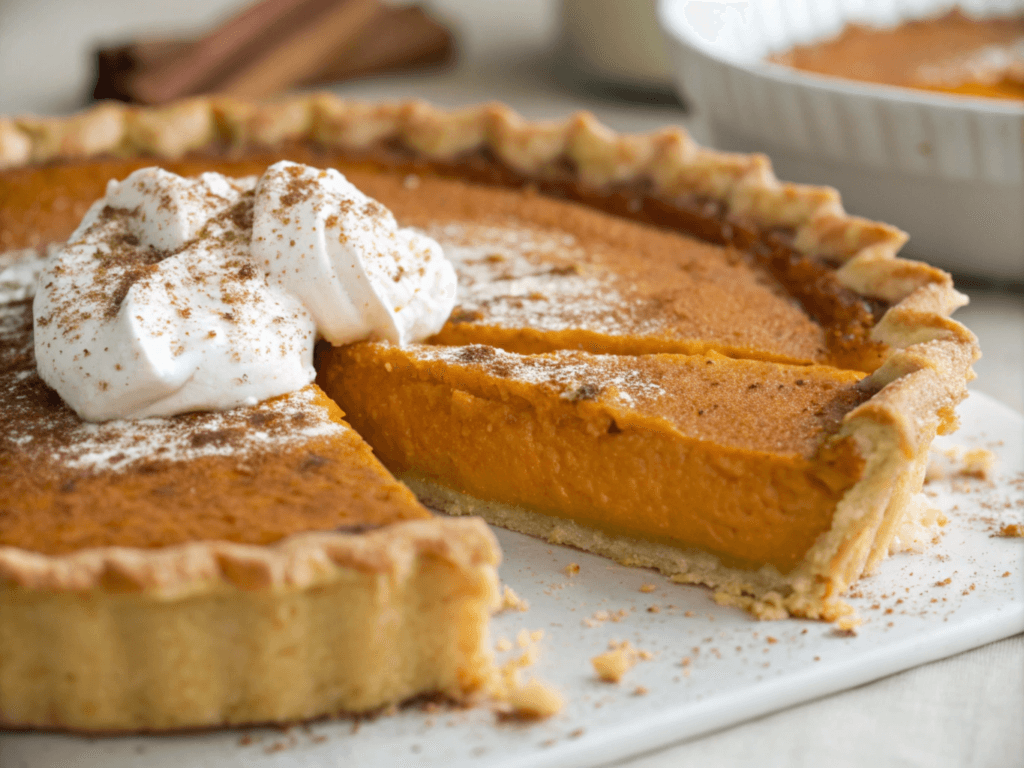
The foundation of any great sweet potato pie starts with—you guessed it—the sweet potatoes. Consequently, choosing the right variety and ensuring that they’re at peak freshness can make a world of difference in the taste and texture of your pie.
Which Sweet Potatoes Are Best?
For a pie with a smooth, creamy filling and natural sweetness, orange-fleshed sweet potatoes are the best choice. Varieties such as Beauregard or Covington are especially popular due to their vibrant color and rich flavor. Moreover, their high moisture content helps create the silky texture that sweet potato pie lovers adore.
How to Pick Perfect Sweet Potatoes
Here are a few tips to guide your selection:
- Look for even skin: Choose sweet potatoes with smooth, unblemished skin free of cuts or bruises.
- Check for firmness: They should feel firm to the touch without any soft spots.
- Size matters: Medium-sized sweet potatoes are ideal. Larger ones can sometimes be stringy, while smaller ones may not yield enough flesh for your pie.
Storage Tips
Once you’ve picked the perfect sweet potatoes, store them in a cool, dark place—not the refrigerator. This is because cold temperatures can alter their texture and taste, resulting in a less flavorful pie. Properly stored sweet potatoes can last for weeks, so you’ll always have them on hand when the craving strikes.
Traditional Sweet Potato Pie Recipe
Now that you’ve selected the best sweet potatoes, it’s time to turn them into a classic sweet potato pie. This recipe is a timeless favorite, blending creamy sweet potatoes with warm spices and just the right amount of sweetness to create a dessert that feels like home.
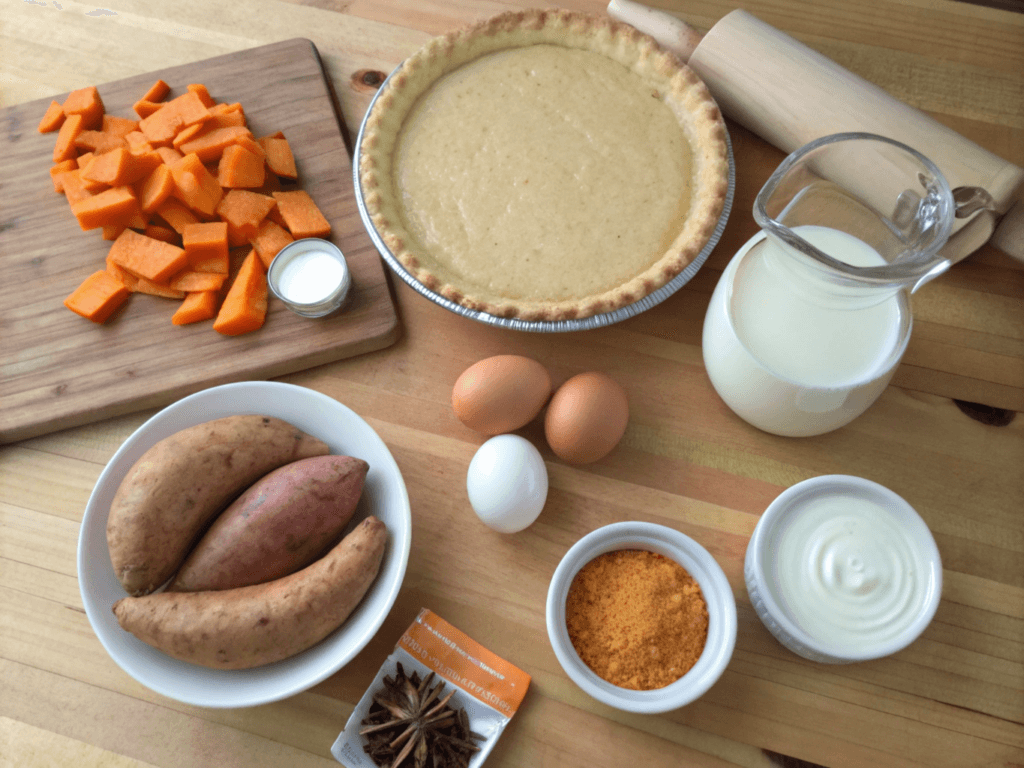
Ingredients
For the filling:
- 2 medium sweet potatoes (about 1 pound)
- 1/2 cup (1 stick) unsalted butter, softened
- 3/4 cup granulated sugar
- 1/2 cup brown sugar, packed
- 2 large eggs, room temperature
- 1/2 cup whole milk
- 1/4 cup heavy cream
- 1 teaspoon vanilla extract
- 1 teaspoon ground cinnamon
- 1/2 teaspoon ground nutmeg
- 1/4 teaspoon ground ginger (optional)
- 1/4 teaspoon salt
For the crust:
- 1 unbaked 9-inch pie crust (homemade or store-bought)
Instructions
- Prep the Sweet Potatoes
- Preheat your oven to 375°F (190°C).
- Wash and pierce the sweet potatoes with a fork. Place them on a baking sheet and bake for 45-60 minutes, or until tender when pierced with a knife.
- Once cooled, peel and mash the sweet potatoes until smooth. You should have about 2 cups of mashed sweet potato.
- Make the Filling
- In a large mixing bowl, beat the softened butter with the mashed sweet potatoes until smooth. Next, add the granulated and brown sugars, mixing well.
- Beat in the eggs one at a time. Then stir in the milk, cream, vanilla extract, cinnamon, nutmeg, ginger (if using), and salt. Mix until the filling is creamy and well-combined.
- Assemble the Pie
- Roll out your pie crust and fit it into a 9-inch pie pan. Trim and crimp the edges as desired.
- Pour the sweet potato filling into the crust, spreading it evenly.
- Bake the Pie
- Bake the pie in the preheated oven for 50-55 minutes, or until the filling is set and slightly puffed around the edges. A toothpick inserted into the center should come out mostly clean.
- If the crust begins to brown too quickly, cover the edges with aluminum foil.
- Cool and Serve
- Let the pie cool completely on a wire rack before slicing. This helps the filling to set properly.
- Serve the pie at room temperature or chilled, with a dollop of whipped cream or a scoop of vanilla ice cream for a delightful treat.
Variations and Dietary Modifications
Sweet potato pie is an incredibly versatile dessert, perfect for adapting to a variety of dietary preferences or simply adding a creative twist. Whether you want a lighter option, an allergy-friendly version, or a unique flavor profile, there are countless ways to customize this classic dish.
Healthier Ingredient Substitutions
- Reduce the Sugar
- Replace half the sugar with natural sweeteners like honey, maple syrup, or coconut sugar for a more wholesome touch.
- Using only 1/2 cup of sugar allows the natural sweetness of the sweet potatoes to shine through.
- Lighten the Fat
- Substitute heavy cream with evaporated milk or coconut milk for a lower-fat option.
- Cut the butter content in half or try a vegan butter alternative for fewer saturated fats.
- Whole-Grain Crust
- Use a pie crust made with whole-wheat flour to increase fiber and add a subtle nutty flavor to your pie.
Vegan Sweet Potato Pie
For a completely dairy- and egg-free version:
- Replace the milk and cream with unsweetened almond milk or coconut cream.
- Use flaxseed meal (1 tablespoon flaxseed meal + 3 tablespoons water = 1 egg) as a substitute for eggs.
- Opt for a vegan pie crust or make one with coconut oil instead of butter.
Gluten-Free Adaptation
- Swap a traditional crust for a store-bought gluten-free crust or make your own using almond flour or gluten-free all-purpose flour.
- Double-check that all other ingredients, such as vanilla extract and spices, are labeled gluten-free.
Flavorful Twists
- Spiked Sweet Potato Pie
- Add a tablespoon of bourbon or rum to the filling for a sophisticated, grown-up variation.
- This subtle hint of alcohol complements the spices beautifully.
- Coconut Sweet Potato Pie
- Mix 1/2 cup of shredded coconut into the filling and use coconut milk for a tropical twist.
- Pecan Topping
- Create a crunchy topping by sprinkling chopped pecans mixed with brown sugar and melted butter on top before baking.
Serving Suggestions
A fresh sweet potato pie is a joy to serve, but thoughtful presentation can make it even more special. Here are some creative ideas to impress your guests.
Classic Pairings
- Whipped Cream
- Add a generous dollop of lightly sweetened whipped cream to each slice.
- To make it more festive, sprinkle the whipped cream with a pinch of cinnamon or a drizzle of caramel.
- Ice Cream
- Vanilla ice cream is a classic choice, but butter pecan or caramel ice cream can make it feel extra indulgent.
Plating for Gatherings
- Garnish with Spices
- Dust a light sprinkle of cinnamon or nutmeg over each slice for an elegant touch.
- Add Citrus Accents
- Place a thin slice of candied orange or lemon zest on top to brighten the flavors and add a decorative flair.
Beverage Pairings
- Coffee or Tea
- Serve your pie with a steaming cup of coffee or spiced chai tea for a comforting combination.
- Dessert
- Enjoy the pie with a sparkling apple cider, sweet peach tea, or a warm spiced apple punch for a flavorful and balanced finish to your meal.”
Storing and Reheating Leftovers
If you find yourself with leftovers, you’ll want to keep your sweet potato pie tasting just as delicious as when it was freshly baked. With proper storage and reheating techniques, it’s easy to savor every slice.
Storing Sweet Potato Pie
- At Room Temperature
- Sweet potato pie can sit at room temperature for up to two hours. After that, transfer it to the refrigerator.
- In the Refrigerator
- Wrap the pie tightly with plastic wrap or aluminum foil and refrigerate it for 3-4 days.
- In the Freezer
- Sweet potato pie freezes wonderfully. Wrap the entire pie or individual slices in plastic wrap, then seal them in an airtight container. For best results, consume within 1-2 months.
Reheating Sweet Potato Pie
- In the Oven
- Preheat your oven to 300°F (150°C).
- Place the pie on a baking sheet and cover it loosely with foil to protect the crust from browning. Warm it for 15-20 minutes.
- In the Microwave
- For individual slices, heat on medium power for 30-second intervals, checking for warmth after each. Avoid overheating to preserve the filling’s creamy texture.
Serving Leftover Pie
- Leftover sweet potato pie tastes wonderful chilled, straight from the fridge.
- Alternatively, enjoy it warm with a fresh dollop of whipped cream or a drizzle of maple syrup.
Tips for Perfect Sweet Potato Pie
Sweet potato pie is a straightforward dessert, but a few thoughtful tips can transform it from delicious to unforgettable. By following these suggestions, you can avoid common pitfalls and make a pie that will wow everyone at the table.
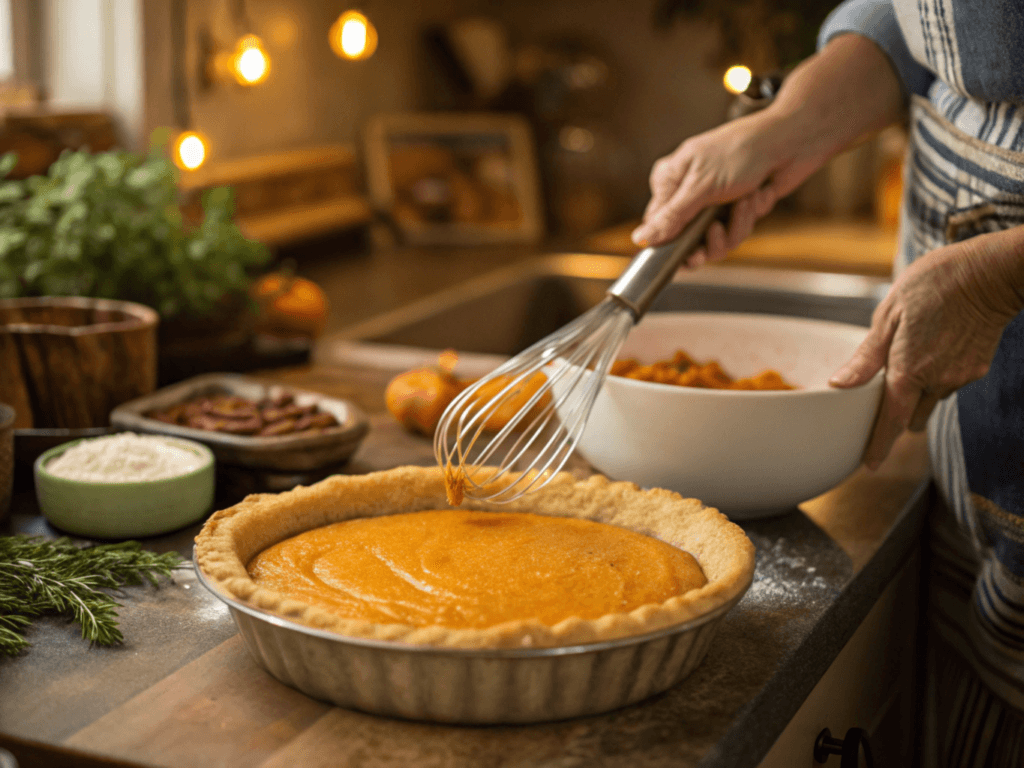
1. Achieving a Smooth Filling
- Mash Thoroughly: Use a hand mixer, food processor, or blender to create a silky texture. If you don’t have these tools, a potato masher will work—just take extra time to eliminate lumps.
- Avoid Strings: Larger sweet potatoes can sometimes have fibrous strings. To remove them, push the mashed sweet potatoes through a fine-mesh sieve or food mill.
2. Perfecting the Crust
- Blind Bake for Crispness: Prevent a soggy crust by blind baking. Line your unbaked pie crust with parchment paper, fill it with pie weights or dried beans, and bake it for 10-15 minutes at 375°F before adding the filling.
- Keep it Cold: A cold crust is easier to work with and bakes up flakier. If you’re making your own, chill the dough for at least 30 minutes before rolling it out.
3. Balancing Flavors
- Use Spices Wisely: Sweet potato pie should highlight the natural flavor of the sweet potatoes, so don’t go overboard with spices. A balanced mix of cinnamon, nutmeg, and vanilla works beautifully.
- Taste as You Go: Before you pour the filling into the crust, taste the mixture. This is your chance to adjust the sweetness or spice levels to your liking.
4. Baking to Perfection
- Don’t Overbake: The pie is done when the edges are set and the center jiggles slightly. It will continue to firm up as it cools. Overbaking can lead to a dry or cracked filling.
- Protect the Edges: If the crust starts browning too quickly, cover the edges with foil or a pie shield to prevent burning.
5. Presentation Matters
- Let it Cool Completely: A properly cooled pie is easier to slice and serves beautifully. Cutting it too soon can cause the filling to lose its shape.
- Add a Finishing Touch: A light dusting of cinnamon, a dollop of whipped cream, or even a sprinkle of crushed nuts can transform your pie into a showstopper.
FAQs About Sweet Potato Pie
Even seasoned bakers occasionally have questions when making sweet potato pie. Whether you’re a first-timer or an expert looking to refine your technique, these answers to common questions will help you perfect this classic dessert.
1. Which color sweet potato is Healthiest?
The “best” sweet potato depends on your nutritional needs:
- If you want more vitamin A, go for orange sweet potatoes.
- If you’re after antioxidants, purple sweet potatoes are the way to go.
- For those who prefer a milder flavor or lower sugar content, white or yellow sweet potatoes may be a better fit.
- For Mor About Colors: Comprehensive guide to Which Color Sweet Potato is Healthiest?
2. Why is my pie filling runny?
A runny filling often happens when the pie hasn’t baked long enough or the mixture has too much liquid. To prevent this:
- Bake the pie until the edges are set, and the center has only a slight jiggle.
- Double-check your liquid measurements—too much milk or cream can thin the filling.
- If your sweet potatoes are particularly watery after mashing, let them drain in a fine sieve for a few minutes before mixing them into the filling.
3. Can I make sweet potato pie ahead of time?
Yes! Sweet potato pie is a perfect make-ahead dessert.
- Bake the pie up to two days in advance, then let it cool completely.
- Wrap it tightly with plastic wrap and refrigerate. When ready to serve, you can bring it to room temperature or gently warm it in the oven.
4. What’s the best way to mash sweet potatoes for the filling?
For a smooth filling:
- Use a blender, food processor, or electric mixer to achieve a velvety texture.
- For a more rustic feel, mash the sweet potatoes by hand with a masher or fork, making sure to eliminate any large chunks.
5. Can I use canned sweet potatoes instead of fresh?
Yes, canned sweet potatoes are a convenient alternative to fresh ones. Just make sure to:
- Choose unsweetened, canned sweet potatoes (sometimes labeled as yams).
- Drain them thoroughly to remove excess liquid, which could otherwise thin the filling.
6. How does sweet potato pie differ from pumpkin pie?
Although both pies are spiced, custard-based desserts, there are some key differences:
- Flavor: Sweet potato pie has a naturally sweeter and earthier flavor, while pumpkin pie is slightly tangier and spicier.
- Texture: Sweet potato pie is denser, whereas pumpkin pie tends to have a lighter, creamier consistency.
- Color: Sweet potato pie usually boasts a richer orange hue due to the natural vibrancy of sweet potatoes.
7. Can I freeze sweet potato pie?
Yes, sweet potato pie freezes beautifully!
- Let the pie cool completely after baking.
- Wrap it tightly in plastic wrap, then in aluminum foil, and place it in the freezer.
- For the best results, thaw the pie overnight in the refrigerator before serving.
8. What spices work best in sweet potato pie?
Classic spices like cinnamon, nutmeg, and vanilla extract bring warmth and depth to the pie. For an extra twist, try adding a touch of ground ginger, allspice, or even cardamom.
9.What Causes Sweet Potato Pie to Crack?
It’s a common frustration among bakers of all skill levels, and this is the ultimate guide to What Causes Sweet Potato Pie to Crack?
A Healthier Sweet Potato Pie: Recipe Variation
If you love the flavors of sweet potato pie but want a lighter version, this healthier recipe has you covered. With just a few tweaks, you can enjoy all the warmth and sweetness of this classic dessert with fewer calories and less fat. Because of these adjustments, it’s a great option for those watching their diet or catering to different dietary needs.
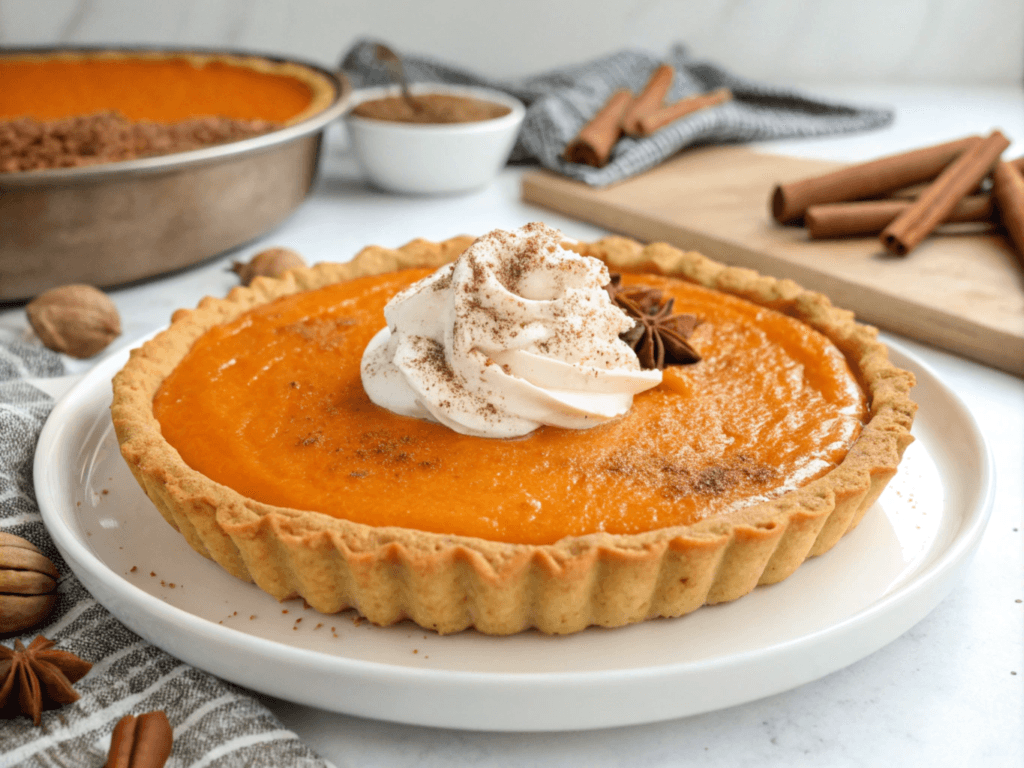
Ingredients for a Healthier Sweet Potato Pie
For the filling:
- 2 medium sweet potatoes (about 1 pound)
- 1/4 cup coconut oil or unsalted butter, melted
- 1/2 cup pure maple syrup (or honey)
- 2 large eggs
- 1/2 cup unsweetened almond milk (or low-fat milk)
- 1 teaspoon vanilla extract
- 1 teaspoon ground cinnamon
- 1/4 teaspoon ground nutmeg
- 1/4 teaspoon ground ginger
- 1/4 teaspoon salt
For the crust:
- 1 pre-made whole-grain or gluten-free pie crust (or make your own using almond flour).
Instructions
- Prepare the Sweet Potatoes
- First, roast or boil the sweet potatoes until tender. After cooking, mash them until smooth.
- Mix the Filling
- In the next step, combine the mashed sweet potatoes with melted coconut oil, maple syrup, and eggs in a large bowl. Then, stir in almond milk, vanilla extract, and spices until the mixture is creamy and well-blended.
- Assemble and Bake
- Pour the filling into the whole-grain or gluten-free crust. Afterward, smooth the top with a spatula.
- Bake in a preheated oven at 375°F (190°C) for 50–55 minutes, or until the filling is set and the edges are slightly puffed.
- Cool and Serve
- Let the pie cool completely before slicing. Finally, serve it with a dollop of Greek yogurt or a sprinkle of chopped nuts for added texture and flavor.
Why It’s Healthier
- Reduced Sugar: Maple syrup or honey replaces granulated sugar, offering natural sweetness with fewer empty calories.
- Lower Fat Content: Coconut oil or reduced butter adds a healthier fat profile while maintaining richness.
- Whole-Grain Crust: Using whole-wheat or almond flour crusts increases fiber and nutrients without sacrificing taste.
Sweet Potato Pie’s Place in the Holidays
Sweet potato pie is not just a dessert—it’s a holiday tradition and a symbol of togetherness. Whether served during Thanksgiving or Christmas, this dish is a staple at family gatherings and brings a sense of warmth and nostalgia to the table.
A Holiday Tradition
In many Southern households, sweet potato pie is as essential as turkey or beef during the holidays. Its earthy sweetness and warm spices evoke a sense of comfort that perfectly complements the celebratory spirit of the season. Furthermore, recipes for this cherished dessert are often passed down through generations, each one carrying stories and flavors that connect the past to the present.
Sweet Potato Pie vs. Pumpkin Pie: The Holiday Debate
During the holiday season, sweet potato pie often finds itself compared to pumpkin pie. Although both are spiced, custard-based desserts, they appeal to different tastes. Many Southerners prefer sweet potato pie for its naturally sweet flavor and denser texture, often describing it as more “authentic” to their traditions. Meanwhile, pumpkin pie tends to dominate in Northern kitchens, offering a lighter and slightly tangier profile. Despite these differences, both pies have earned their places at the holiday table.
Memories in Every Bite
For some families, the holidays wouldn’t be the same without the aroma of sweet potato pie baking in the kitchen. Often, this dessert encourages a sense of connection, whether it’s through preparing the pie together or sharing stories over a slice. In fact, some families even host friendly “pie-offs,” comparing recipes to determine whose version is the best.
Modern Celebrations
Although sweet potato pie has deep roots in Southern tradition, it has gained widespread appeal across the country. Its adaptability and rich history make it a welcome addition to diverse celebrations, from casual dinners to formal holiday feasts.
Conclusion
Sweet potato pie is more than just a dessert—it’s a celebration of flavor, tradition, and community. From its humble beginnings in Southern kitchens to its place of honor at modern holiday feasts, this classic dish continues to bring people together around its creamy, spiced filling and flaky crust. Whether you follow a time-tested recipe or put your own spin on it, sweet potato pie is a dessert that feels like a warm hug in every bite.
Moreover, baking a sweet potato pie is about more than the final product. It’s an opportunity to connect with family, create new traditions, and honor old ones. Each slice carries the love, care, and memories of the hands that made it.
We encourage you to give this recipe a try! If you do, let us know how it turned out. Did you stick to the classic recipe, or did you experiment with a variation? Share your experiences and tips in the comments below. Don’t forget to bookmark this recipe for your next special occasion—or for when you simply want a taste of comfort.

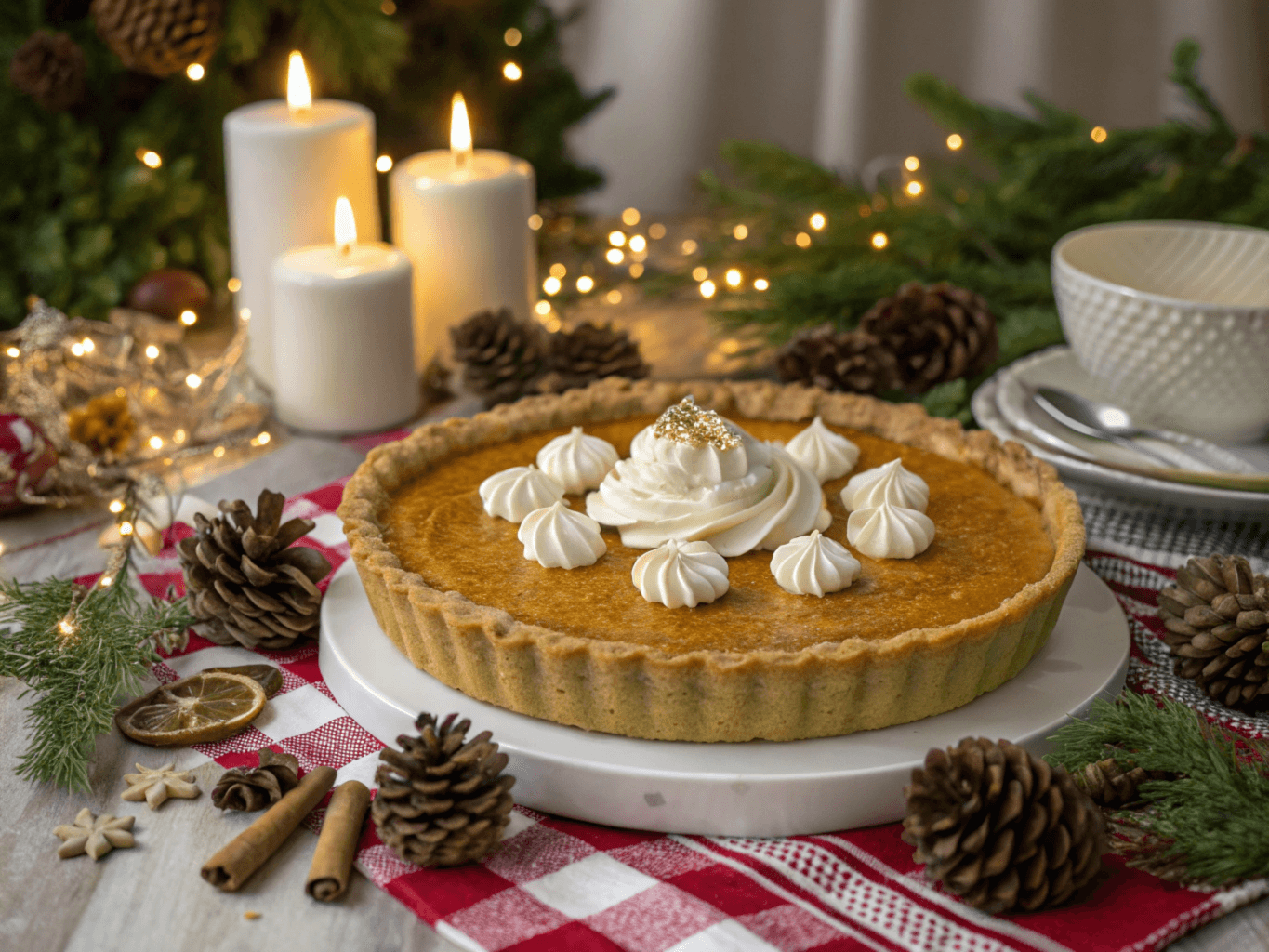
26 thoughts on “The Best Sweet Potato Pie Recipe – Classic and Easy to Make”
Comments are closed.